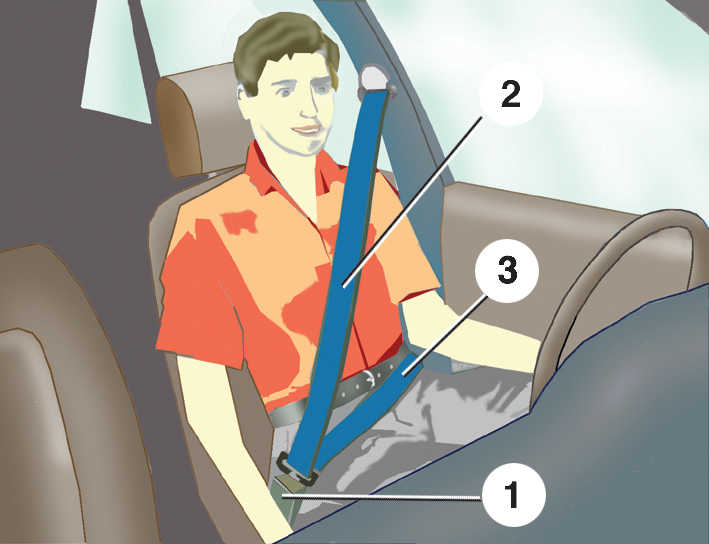
How to properly fasten your seat belt
Content
For people ages 3 to 34, the leading cause of death in the US is car accidents. The number of auto accident-related deaths in the US has declined since the 1960s, largely due to the introduction and use of seat belts and other safety devices. However, more than 32,000 people die each year, and roughly half of those deaths could have been prevented if seat belts were properly fastened.
Seat belts were fitted to some Ford models as early as 1955, and they became commonplace in cars shortly thereafter. While there is overwhelming evidence that proper use of a seat belt can save a life in a crash, many people choose to either wear their seat belt incorrectly or not use it at all. Reasons for not wearing seat belts and their counterarguments can be seen in the table below:
Regardless of the circumstances, using a seat belt every time you are in a car, whether as a passenger or driver, is a must practice. Proper use will increase your defense in the event of an unfortunate encounter.
Method 1 of 2: Wear the shoulder strap correctly
In the vast majority of cars, manufacturers install shoulder belts in all possible positions. The driver, front passenger and almost every passenger in the back seat must wear shoulder belts in cars made within the last decade. While middle seat passengers may still only have lap belts, in the vast majority of cases, shoulder belts are installed for the driver and passengers.
Step 1: Position yourself correctly. Sit with your back against the back of the seat and lean your hips fully back.
If you are not seated straight up to the back of the seat, the belt may sag more than it should, which could lead to serious injury in the event of an accident.
Step 2 Pull the shoulder strap across your body.. With your hand closest to the seat belt, lift your shoulder and grasp the metal latch on the seat belt.
Pull it across your body to the thigh on the opposite side of the arm you are using.
The seat belt buckle is located on the opposite thigh.
- Functions: Make sure the seat belt strap is not twisted for maximum wearing comfort.
Step 3. Use your other hand to locate the seat belt buckle.. Grasp the buckle and make sure the top slotted end is pointing up and the release button is on your side.
- Functions: In the event of a collision, or even just to facilitate release when exiting the vehicle, it is important that the seat belt buckle button is on the outside of the seat belt buckle, otherwise access and release may be difficult.
Step 4: Insert the seat belt. Align the seat belt latch on the buckle with the slot on the top of the buckle and fully insert it.
You should hear a click when the buckle fully engages and snaps into place on the seat belt latch.
Step 5: Make sure you're fully protected. Pull the seat belt buckle to make sure it is fully fastened.
Step 6: Adjust the shoulder strap to fit your body. Adjust your seat belt every time you put on your seat belt to make sure it fits you.
The perfect place for the shoulder strap to cross your body at the collarbone.
Adjust the height of the seat belt on the pillar if your vehicle has an adjustment.
Alternatively, if you have seat height adjustment, you can raise or lower the seat height to compensate for the position of the seat belt over the shoulder.
Step 7: Tighten the belt at the hips. Make sure the lap part of the belt is low on the hips and snug.
If the lap belt is loose, you could “float” under it in the event of an accident, resulting in injury that would not have occurred if the belt had been taut.
Method 2 of 2: Fasten Your Waist Belt Properly
Whether you have a shoulder belt or only a lap belt, it is important to wear it correctly to avoid injury in a collision.
Step 1: Sit up straight. Sit up straight with your hips back on the seat.
Step 2: Place the waist belt over your hips.. Swing the seat belt over your hips and align the belt with the buckle.
Step 3: Insert the seat belt into the buckle. While holding the seat belt buckle with one hand, press the seat belt latch in the buckle.
Make sure the button on the buckle is on the side of the buckle away from you.
Step 4: Tighten the waist belt. Adjust the waist belt so that it fits snugly around your waist and the slack in the belt is eliminated.
Position the belt low on your hips, then pull the free end of the waist belt away from the buckle to tighten it.
Pull until the belt is no longer slack, but not until it creates a dent in your body.
Seat belts are devices that have been proven to save lives. For your own safety and the safety of your passengers, you must follow the rule in your vehicle that every passenger must wear a seat belt at all times.
